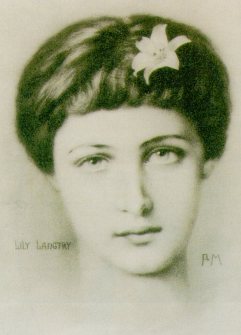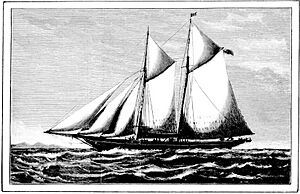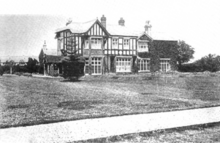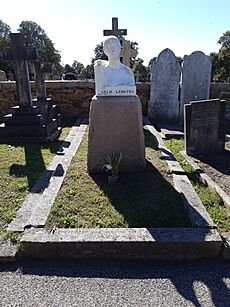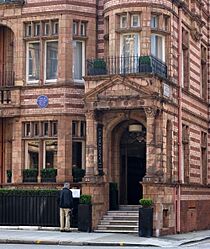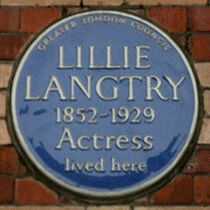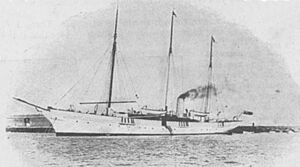Lillie Langtry facts for kids
Emilie Charlotte, Lady de Bathe (born Le Breton, formerly Langtry; 13 October 1853 – 12 February 1929), known as Lillie Langtry and nicknamed "The Jersey Lily", was a famous British socialite, stage actress, and producer. A socialite is someone well-known in fashionable society.
Born on the island of Jersey, she moved to London in 1876 after getting married. Her beauty and charm made her very popular. She was admired by artists and important people in society. During the Aesthetic movement in England, which focused on beauty in art and life, artists painted her. In 1882, she became the face of Pears Soap. This made her the first celebrity to advertise a product.
In 1881, Lillie Langtry started acting. She made her first big appearance in London's West End in the play She Stoops to Conquer. It was a big deal because she was the first socialite to become a stage actress. She went on to star in many plays in the United Kingdom and the United States. These included The Lady of Lyons and Shakespeare's As You Like It. She even started her own theatre company. Later in her life, she performed short "dramatic sketches" in vaudeville, a type of entertainment with different acts. From the mid-1890s until 1919, Langtry lived at Regal Lodge in Newmarket, England. There, she ran a very successful horse racing stable. The Lillie Langtry Stakes horse race is named after her.
Lillie Langtry was one of the most glamorous British women of her time. Many people and newspapers were interested in her. Her friends in London included the famous writer Oscar Wilde, who encouraged her to act. She was known for her friendships with important figures, including the future King Edward VII.
Contents
- Early Life and Fame
- Acting Career and Theatre Management
- Thoroughbred Horse Racing
- Friendship with William Gladstone
- American Citizenship and Divorce
- Hugo Gerald de Bathe
- Later Life and Death
- Cultural Impact and Portrayals
- Places Connected with Lillie Langtry
- Steam Yacht White Ladye
- Images for kids
- See also
Early Life and Fame
Lillie was born in 1853 and was known by that name since childhood. Her father was the Very Reverend William Corbet Le Breton, and her mother was Emilie Davis. Lillie was born at the Old Rectory in St Saviour, on Jersey. She was baptized in St Saviour on 9 November 1853.
Lillie was the sixth of seven children and the only girl. She had six brothers. Lillie was taught by her brothers' tutor because her French governess found her difficult to manage. This meant she received a broader and more thorough education than most girls at that time.
From Jersey to London
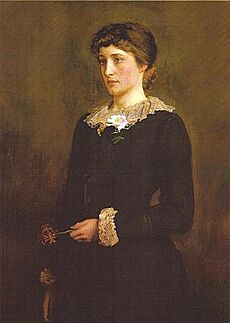
On 9 March 1874, 20-year-old Lillie married Edward Langtry, an Irish landowner. He was 26 and had been married before. Lillie and Edward had their wedding party at The Royal Yacht Hotel in St. Helier, Jersey. Edward Langtry was rich enough to own a large yacht called Red Gauntlet. Lillie wanted to leave the Channel Islands, so they moved to London. In 1876, they rented an apartment in Eaton Place, Belgravia. By early 1878, they moved to a bigger home at 17 Norfolk Street to welcome more of Lillie's many visitors.
Lillie Langtry once explained how she became famous in London society. She said that friends and artists like Frank Miles introduced her. Mr. Miles saw her at the theatre and was determined to find out who she was. He described her to everyone until a friend introduced them. Then, Mr. Miles asked her to pose for a portrait. She agreed, and the portrait was sold to Prince Leopold. After that, she was invited everywhere and became very popular with royal family members and noble people. She also posed for other famous artists like John Everett Millais and Edward Burne-Jones.
In 1877, Lillie met Lord Ranelagh, a friend of her father. He invited her to a party where many famous artists were present. Lillie was in mourning for her youngest brother, who had died in a riding accident. So, she wore a simple black dress and no jewelry, unlike the fancy clothes of other women. Her simple look and beauty caught everyone's attention. Before the night ended, artist Frank Miles had already drawn several sketches of her. These sketches became very popular on postcards. Another artist, Sir John Everett Millais, who was also from Jersey, later painted her portrait.
Langtry's nickname, "the Jersey Lily," came from the Jersey lily flower (Amaryllis belladonna), a symbol of Jersey. Millais' portrait, titled A Jersey Lily, made the nickname famous. The painting was so popular when shown at the Royal Academy that it had to be roped off to protect it from the crowds. Lillie became very sought after in London society, and invitations poured in. Her fame soon reached the ears of royalty.
Royal Friendships

The prince of Wales, Albert Edward (who later became Edward VII), arranged to sit next to Langtry at a dinner party in May 1877. The Prince was very impressed with Langtry. She was even introduced to the Prince's mother, Queen Victoria. The Prince's wife, Princess Alexandra of Denmark, was understanding and accepted Lillie.
Lillie's friendship with the Prince lasted for several years. Even after their closest friendship changed, they remained good friends. The Prince continued to support her, especially in her acting career. He used his influence to help her succeed.
The Langtrys' money was not enough for their expensive lifestyle. In October 1880, Lillie sold many of her belongings to pay off her debts. This helped Edward Langtry avoid going bankrupt.
Acting Career and Theatre Management
In 1881, Lillie Langtry needed money. Her good friend Oscar Wilde suggested she try acting. Langtry began her theatre career. She first performed in an amateur play called A Fair Encounter in November 1881. She was coached by Henrietta Labouchère, a former actress. After good reviews, Langtry made her public debut in London. She played Kate Hardcastle in She Stoops to Conquer at the West End's Haymarket Theatre in December 1881. Some critics had mixed opinions, but the public loved her. She then performed in Ours at the same theatre. Even though her close friendship with the Prince of Wales had changed, he supported her new career by attending her shows, which helped attract large audiences.
In early 1882, Langtry left the Haymarket production and started her own theatre company. She toured the UK with different plays, still learning from Henrietta Labouchère. An American theatre manager, Henry Abbey, arranged a tour for Langtry in the United States. She arrived in October 1882 and was met by reporters and Oscar Wilde. Her first show was highly anticipated, but the theatre burned down the night before. The show moved to another place and opened the next week. Her company then toured across the US, making a lot of money by May 1883.
During her first US tour, the public loved her, even though critics often found fault with her acting. After returning from New York in 1883, Langtry studied at the Conservatoire in Paris for six weeks. This intensive training helped her improve her acting skills.
In 1889, she played Lady Macbeth in Shakespeare's Macbeth. In 1903, she starred in the US in The Crossways, a play she wrote with J. Hartley Manners. She returned to the US for tours in 1906 and again in 1912, appearing in vaudeville. Her last stage appearance in America was in 1917. Later that year, she performed for the last time in a London theatre.
From 1900 to 1903, with money from Edgar Israel Cohen, Langtry became the manager of London's Imperial Theatre. It opened on 21 April 1901, after being completely renovated. Today, the Westminster Central Hall stands where the theatre once was. In 1913, Langtry starred in her only film, His Neighbor's Wife, directed by Edwin S. Porter.
Thoroughbred Horse Racing
For almost ten years, from 1882 to 1891, Langtry was involved with an American named Frederick Gebhard. He was a wealthy young sportsman and horse owner.
With Gebhard, Langtry became very interested in horse racing. In 1885, she and Gebhard brought American horses to race in England. In 1888, a train car carrying 17 of their horses derailed in Shohola, Pennsylvania. It rolled down a hill and caught fire. One person died, along with Gebhard's champion horse Eole and 14 other racehorses belonging to him and Langtry. Two horses survived, including St. Saviour, named after St. Saviour's Church in Jersey, where Langtry's father was a rector and where she wished to be buried.

In 1889, Langtry met George Alexander Baird, a wealthy sportsman with large estates and a racing stable. They met at a racecourse when he gave her a tip for a horse race. The horse won, and Baird later offered her a horse named Milford as a gift. She accepted, and the horse won several races under Langtry's racing colors. The horse was registered to "Mr Jersey" because women were not allowed to register horses at that time. Langtry became close with Baird until his death in March 1893.
When Baird died, Langtry bought two of his horses, Lady Rosebery and Studley Royal. She moved her horses to Sam Pickering's stables and lived at Regal Lodge in the village of Kentford, near Newmarket, Suffolk. This building was close to Baird's original horse breeding place.
Langtry learned a lot about horse racing from Captain James Octavius Machell and Joe Thompson. When her trainer, Pickering, didn't get good results, she moved her 20 horses to Fred Webb's stables. In 1899, James Machell sold his stables to Colonel Harry Leslie Blundell McCalmont, a rich racehorse owner who was also Langtry's brother-in-law.
Langtry bought a horse from Australia called Merman and had it shipped to England. Shipping horses was risky, and she had a bad experience before. Merman became known as one of the best long-distance racehorses. He won many important races, including the Lewes Handicap, the Cesarewitch, and the Ascot Gold Cup. Langtry later had another Cesarewitch winner with Yentoi, and a third-place finish with Raytoi. A horse from New Zealand named Uniform also won the Lewes Handicap for her.
Other trainers Langtry used included Jack Robinson and a young Fred Darling, whose first big success was Yentoi's Cesarewitch win in 1908.
Langtry also owned a horse breeding farm at Gazely, Newmarket. This business was not successful. After a few years, she stopped trying to breed racehorses. Langtry sold Regal Lodge and all her horse-racing interests in 1919 before moving to Monaco. Regal Lodge had been her home for 23 years and hosted many famous guests, including the Prince of Wales.
To honor her contributions to horse racing, the Glorious Goodwood meeting has held the Group 2 Lillie Langtry Stakes since 2014.
Friendship with William Gladstone
During her acting career, Lillie Langtry became friends with William Gladstone (1809–1898). He was the Prime Minister of Britain four times during Queen Victoria's reign. In her memories, Langtry said she first met Gladstone when she was posing for her portrait at Millais' studio. They became friends, and he became a mentor to her. He gave her advice, saying, "In your professional career, you will receive attacks, personal and critical, just and unjust. Bear them, never reply, and, above all, never rush into print to explain or defend yourself."
American Citizenship and Divorce
In 1888, Langtry became a property owner in the United States. She and Frederick Gebhard bought neighboring ranches in Lake County, California. She started a winery with about 4,200 acres (17 km²) in Guenoc Valley, producing red wine. She sold it in 1906. The winery and vineyard, still called Langtry Farms, are still operating in Middletown, California.
During her travels in the United States, Langtry became an American citizen. On 13 May 1897, she divorced her husband Edward in Lakeport, California. Her ownership of land in America was used in court to show the judge that she was a citizen of the country. Edward Langtry died a few months later in Chester Asylum. His death was likely from a brain hemorrhage after a fall. He was buried in Overleigh Cemetery.
Langtry continued to be involved with her husband's Irish properties after his death. These were bought from her by the government in 1928 under the Northern Ireland Land Act, 1925. This law was passed to transfer certain lands from owners to tenants.
Hugo Gerald de Bathe
In 1899, Lillie Langtry married 28-year-old Hugo Gerald de Bathe (1871–1940). He was the son of Sir Henry de Bathe, 4th Baronet. The wedding took place in St Saviour's Church, Jersey, on 27 July 1899. This was the same day that Langtry's horse Merman won the Goodwood Cup. In December 1899, Hugo de Bathe volunteered to join the British forces in the Boer War. In 1907, Hugo's father died, and he became the 5th Baronet. This meant Langtry became Lady de Bathe.

When Hugo de Bathe became the 5th Baronet, he inherited properties in Sussex, Devon, and Ireland. The properties in Sussex were in the village of West Stoke near Chichester. These included Woodend, Hollandsfield, and Balsom's Farm. Woodend was kept as the de Bathe family home, while the smaller Hollandsfield was rented out. Today, the buildings still look old, but they have been changed and added to. The complex now has many different homes. One of the houses is named Langtry and another Hardy. All the de Bathe properties were sold in 1919, the same year Lady de Bathe sold Regal Lodge.
Later Life and Death
In her final years, Langtry, as Lady de Bathe, lived in Monaco. Her husband, Sir Hugo de Bathe, lived in Vence, France. They saw each other at social events or for short private visits. During World War I, Hugo de Bathe was an ambulance driver for the French Red Cross.
Langtry's closest friend in Monaco was Mathilde Marie Peat. Peat was with Langtry when she died from pneumonia in Monte Carlo on 12 February 1929. Langtry had asked to be buried in her parents' tomb at St. Saviour's Church in Jersey. Snowstorms delayed the journey, but her body was taken to St Malo and then to Jersey on 22 February. Her coffin stayed in St Saviour's Church overnight, surrounded by flowers. She was buried on the afternoon of 23 February.
Cultural Impact and Portrayals
Langtry used her fame to advertise products like cosmetics and soap. This was an early example of a celebrity endorsing a product. She used her famous pale skin to earn money, becoming the first woman to advertise Pears Soap in 1882. The Aesthetic movement in England became involved in advertising. Pears Soap, with advertising expert Thomas J. Barratt, hired Langtry to promote their products. They even put her "signature" on the advertisements.

Lillie Langtry has been shown in two films. Lilian Bond played her in The Westerner (1940), and Ava Gardner played her in The Life and Times of Judge Roy Bean (1972).
In 1978, Langtry's story was made into a TV series called Lillie, starring Francesca Annis as Lillie. Annis had also played Langtry in two episodes of Edward the Seventh. Jenny Seagrove played her in the 1991 TV film Incident at Victoria Falls.
Langtry is a character in the fictional The Flashman Papers novels by George MacDonald Fraser. She is described as a former love of the main character, Harry Flashman.
Some people believe Langtry was an inspiration for Irene Adler, a character in the Sherlock Holmes stories by Sir Arthur Conan Doyle. In "A Scandal in Bohemia", Adler outsmarts Holmes, perhaps the only woman to do so.
Lillie Langtry is also the inspiration for The Who's 1967 song "Pictures of Lily". This was mentioned in Pete Townshend's 2012 book Who I Am.
In The Simpsons 1994 episode "Burns' Heir", auditions are held in the Lillie Langtry Theater on Mr. Burns' estate.
Langtry is a character in the play Sherlock Holmes and the Case of the Jersey Lily by Katie Forgette. In this play, she is being blackmailed over old letters. She and Oscar Wilde hire Sherlock Holmes and Dr. Watson to help her.
Places Connected with Lillie Langtry
Residences and Historical Namesakes
When first married in 1874, Edward and Lillie Langtry owned a property called Cliffe Lodge in Southampton, Hampshire. Langtry lived at 21 Pont Street, London, from 1890 to 1897. She had eight servants living with her in 1891. Even after the building became the Cadogan Hotel in 1895, she would still stay in her old bedroom there. A blue plaque on the hotel remembers this, and the hotel's restaurant is named 'Langtry's' in her honor.
A short walk from Pont Street was a house at number 2 Cadogan Place, where she lived in 1899. From 1886 to 1894, she owned a house in Manhattan, New York, at 362 West 23rd Street. This was a gift from Frederick Gebhard.
Langtry's London address from 1916 until at least 1920 was Cornwall Lodge, Allsop Place, Regent's Park. She gave this address when sailing across the Atlantic in August 1916.
There are two bars in New York City named Lillie's Victorian Establishment, dedicated to her memory. Judge Roy Bean named his saloon in Pecos, Texas, "The Jersey Lily" after her. This saloon also served as the judge's courthouse in Langtry, Texas (which was named after an unrelated engineer).
Misleading Associations
Bournemouth
In 1938, the new owners of the Red House in Bournemouth turned it into a hotel. They claimed it was built for Lillie Langtry by the Prince of Wales. A plaque was even put on the hotel saying this. In the late 1970s, the hotel was renamed Langtry Manor. However, despite these claims and local stories, there is no real connection between Langtry and the house. The Prince never visited it.
South Hampstead
In 1965, a woman named Electra Yaras claimed that Lillie Langtry had lived in Leighton House in South Hampstead and entertained the Prince of Wales there. Yaras even said she had been visited by Langtry's ghost in the house. These claims were made to try and save the house from being torn down. However, research in 2021 showed that the house had no connection to Langtry.
Despite this, Langtry's name is still used in some places in the South Hampstead area. These include Langtry Road, Langtry Walk, and the Lillie Langtry pub (now closed) on Abbey Road. There is also The Lillie Langtry pub on Lillie Road in Fulham, but that road was actually named after a local landowner, John Scott Lillie.
Steam Yacht White Ladye
Lillie Langtry owned a fancy steam yacht called White Ladye from 1891 to 1897. The yacht was built in 1891 for Lord Asburton. It had three masts, was 204 feet (62 meters) long and 27 feet (8.2 meters) wide, and was powered by a 142 horsepower steam engine. Its original name was Ladye Mabel.
In 1893, Ogden Goelet leased the yacht from Langtry and used it until he died in 1897. Langtry then put the White Ladye up for auction in November 1897. It was sold to a Scottish businessman named John Lawson Johnston, who created Bovril. He owned it until he died on board in 1900. From 1902 to 1903, the yacht was owned by shipbuilder William Cresswell Gray. After 1915, it became a French fishing boat called La Champagne. It was taken apart in 1935.
Images for kids
See also
 In Spanish: Lillie Langtry para niños
In Spanish: Lillie Langtry para niños




